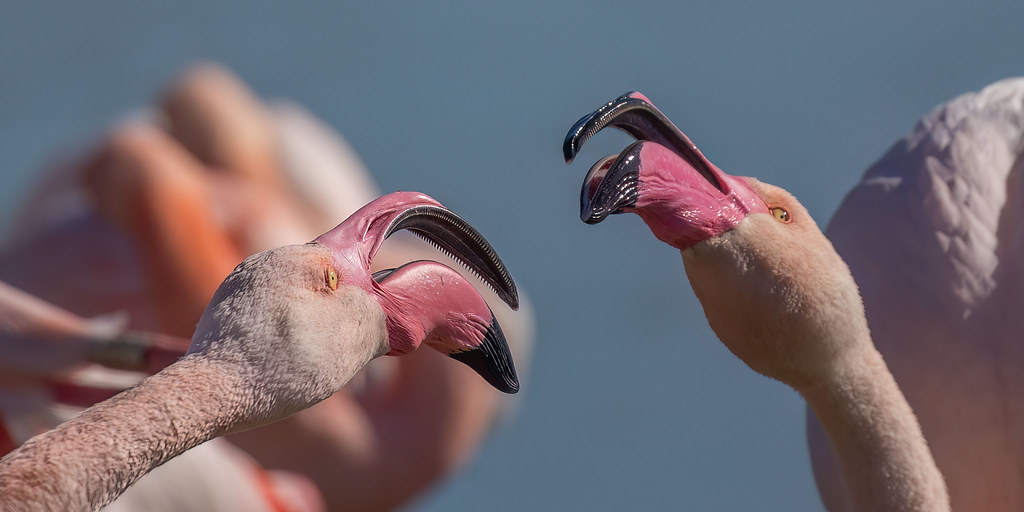#Phoenicopteridae
Text

Greater Flamingos (Phoenicopterus roseus) courtship ritual, family Phoenicopteridae, order Phoenicopteriformes, The Camargue, France
photograph by Lumir Koutnik
#falmingo#phoenicopteridae#phoenicopteriformes#phoenicopterus#wading bird#bird#ornithology#animals#nature#europe
894 notes
·
View notes
Text

A group of Andean flamingoes (Phoenicoparrus andinus) engage in a mating display at Slimbridge Wildfowl and Wetland Trust, England
by Barbara Evans
#andean flamingo#phoenicoparrus andinus#phoenicoparrus#Phoenicopteridae#Phoenicopteriformes#aves#chordata#captive animal#wwt slimbridge#wwt
658 notes
·
View notes
Text
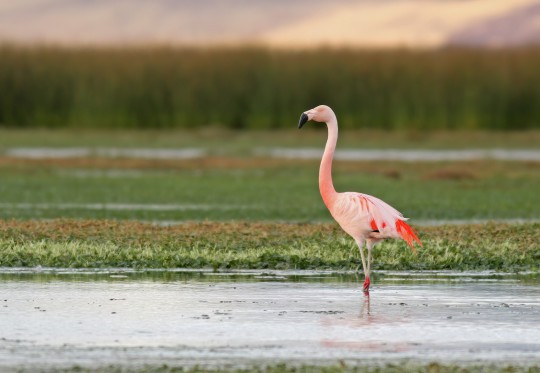
[2333/11080] Chilean flamingo - Phoenicopterus chilensis
Order: Phoenicopteriformes (flamingos)
Family: Phoenicopteridae
Photo credit: Jeremiah Trimble via Macaulay Library
#birds#Chilean flamingo#Phoenicopteriformes#Phoenicopteridae#Phoenicopterus#birds a to z#undescribed
111 notes
·
View notes
Text
A Brief History of Flamingos
People wanted it so here it is, a brief rundown of flamingos throughout prehistory, which is essentially a brief summary of extinct flamingo species that I worked on for Wikipedia.
Because of this, I'll stick to the two main famillies, the Palaeolodidae ("swimming flamingos") and Phoenicopteridae (true flamingos) and leave aside the misc. early forms we don't know are actually related or not.
Palaelodidae
Palaelodids, occasionally referred to as "swimming flamingos" are an interesting and surprisingly long lasting group, containing 3 genera, 10 species and ranging from the Oligocene to the Pleistocene across all continents bar Africa and Antarctica.
The oldest palaelodid is Adelalopus hoogbutseliensis from the Early Oligocene of Belgium. Not much to be said other than that its name is an anagram of Palaelodus.
Palaelodus is the most widespread of the genera in the family, with the type species being Palaelodus ambiguus from the Oligocene and Miocene of Europe. I did actually make a whole post about the genus before here. Anyways, P. ambiguus is the best known species thanks to the ample material collected at Saint-Gérand-le-Puy, France. Remains were also found in Germany and maybe Brazil?
Brazil is interesting, because already by the Oligocene palaelodids were nearly cosmopolitan. Two other species, Palaelodus pledgei and Palaelodus wilsoni, have been recovered from the Oligocene to Miocene of Australia, half a world away from P. ambiguus. P. pledgei is the smallest known species of Palaelodus.
During the early Miocene we also get Palaelodus aotearoa, from New Zealand, and from the middle Miocene Palaelodus kurochkini from Mongolia. The later of the two may in fact be its own genus, but for now its deemed Palaelodus.
Generally, Palaelodus is less specialised than flamingos, though living in brackish waters and feeding on small aquatic insects, they didn't yet have the same suffisticated filter feeding bill as todays flamingos. Whats debated is how they moved. Some suggest wading, others diving and again others propose the idea that they may have been swimmers.
There is one more note on this group, which is that there are some remains assigned to P. wilsoni that appear to have been Pleistocene in age? Obviously this would be a massive deal, but it has also been suggested that this could be a new species given the time gap or a whole new genus. Still, palaelodid remains from the Pleistocene are still incredible.
Palaelodus by Alphinyx and Tom Simpson


The last member of the Palaelodidae is Megapaloelodus. Yes they misspelled Palaelodus in the genus name. The definition of this form is kinda vague and mostly based on size, which is why there's so many issues around Megapaloelodus goliath. You see it was initially described based on its size, but when larger remains of Megapaloelodus were found it was transferred to that genus. However, all other Megapaloelodus species are from the Americas, so thats kinda odd, although of course not a dealbreaker. Still, future research might change things up here.
While Megapaloelodus goliath was contemporary and found at the same place as Palaelodus ambiguus, all others are found in Miocene to Pliocene deposits of America.
Megapaloelodus connectens is the type species and known from the Miocene of South Dakota and California.
Megapaloelodus peiranoi may be the basalmost species and was discovered in Miocene deposits of Argentina.
Finally, we got Megapaloelodus opsigonus from Oregon and possibly Baja California. As this is the youngest species, from the Pliocene, its name means "born in a later age".
Megapaloelodus by Joschua Knüppe (with Argentavis) and Scott Reid

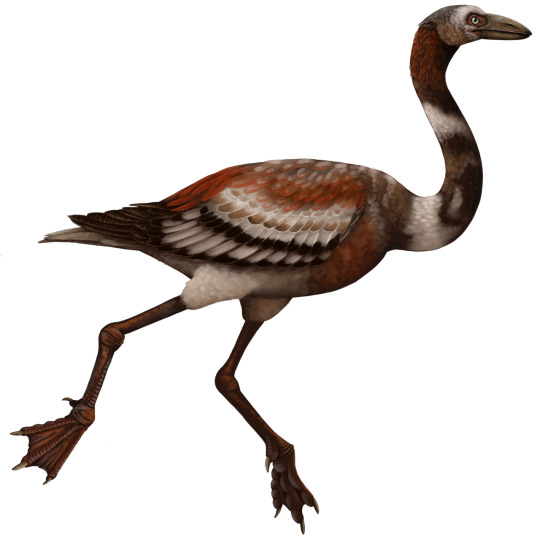
Which actually wraps up palaelodids. Yeah the majority of studies are focused on palaelodids, no surprise given its the only one with really good remains. But based on said animal, its a fascinating group.
This means we can move on to true flamingos, members of the family Phoenicopteridae. I hope you like that name btw, because goddamn "Phoenico" is an overused prefix for these animals to a ridiculous degree. Even I struggled keeping up.
Just to set the stage, lets establish the modern flamingos, split into two to three genera. There is the Lesser Flamingo (Phoeniconaias minor), the only extant member of its genus and native to Africa and Asia. There are two species of Phoenicoparrus, the Andean and Jame's flamingos (Phoenicoparrus andinus and Phoenicoparrus jamesi respectively), both endemic to South America. And then there's the three species of Phoenicopterus. The incredibly whidespread Greater Flamingo (Phoenicopterus roseus), the American Flamingo (Phoenicopterus ruber) and the Chilean Flamingo (Phoenicopterus chilensis). As if the Greater and American flamingos didn't already have latin names way too similar, they were also synonyms for a while so thats fun when they get brought up in old papers.
Chart of living flamingos by Mr. Gharial

Anyways, lets reset to the Oligocene and do this semi-chronologically as before. And yes, Oligocene. Because contrary to what you might think, palaelodids, as we currently think of them as, aren't the ancestors to flamingos and more a really weird sister group that appeared from the same common ancestor aroundt he same time.
Thankfully, we get to start with something fun and not confusing, Harrisonavis croizeti. Another one I did actually cover in detail on Tumblr right here. The short of it is that Harrisonavis already bears the hallmarks of modern flamingos, possessing that classic curved bill and certainly doing some filter feeding already. And if you paid attention you might recognize where its from. Saint-Gérand-le-Puy, France. Yup, this guy coexisted with Palaelodus and Megapaloelodus. Must have been a fascinating place.
Harrisonavis and Palaelodus by Joschua Knüppe

Of course this being a well known form, we gotta follow it up with something bad. Elornis is, simply put, a mess. We aren't even super sure if its a flamingo or not and its history is convoluted. All we can say for sure is that it lived during the late Oligocene in France.
Like palaelodids, true flamingos seem to have dispersed rapidly, as our next entry managed to reach Australia by the late Oligocene. Phoeniconotius eyerensis, I repeat that one, PhoenicoNOTIUS (you see what I mean with things getting confusing?) is a genus from the Lake Eyre Basin of South Australia. It was a comparably robust animal, much more massive than other flamingos and perhaps more of a wader than a swimmer, staying away from deeper waters?
Same time same place we got Phoenicopterus novaehollandiae. PhoenicoPTERUS, as in the same genus as American and Greater flamingos. Now this guy sticks mostly to the same stuff as its relatives, thus differing clearly from Phoeniconotius.
Phoeniconotius (foreground), Phoenicopterus novaehollandiae (?, middle) and palaeolids (background) by Frank Knight, Phoeniconotius by Anne Musser


We can now move into the Miocene. We get a brief break from Phoenico names courtesy of Leakeyornis aethiopicus from Kenya. Tho its not super well preserved, its among the few fossil flamingos with known skull remains, so thats gotta count for something.
Skeletal by me, art by Joschua Knüppe
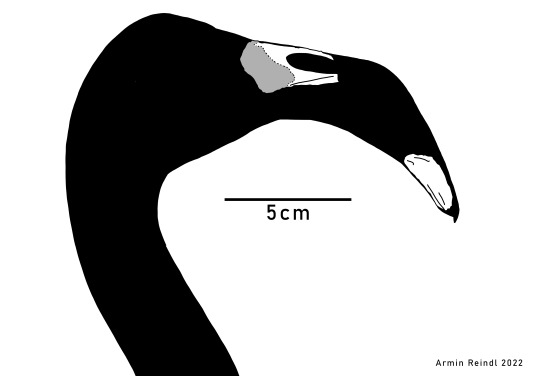
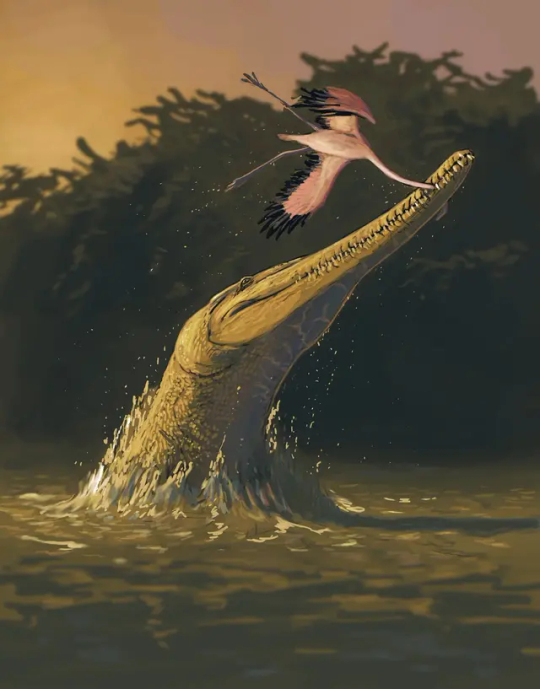
Also during the Miocene, we get the appearance of the genus Phoeniconaias (PhoenicoNAIAS) thanks to Phoeniconaias siamensis. A small species, only slightly larger than today's Lesser Flamingo, its remains are exclusively known from the Mae Long Reservoir in northern Thailand.
Fossil material of P. siamensis alongside a Lesser Flamingo via เบิร์ดโบราณ - Ancient bird on Facebook
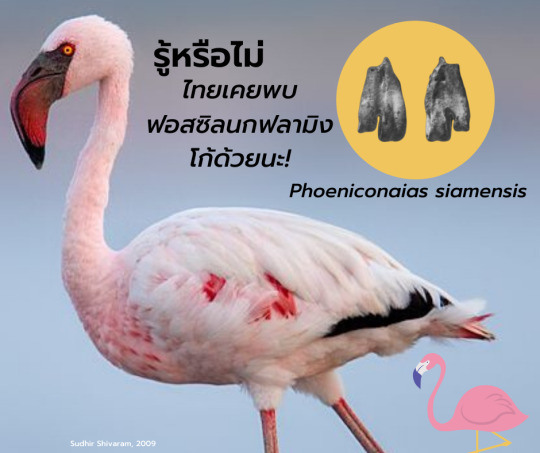
And already we find ourselves in the Pliocene. Oh how time flies. Lets wrap up known fossil species of Phoeniconaias then while we're at it. Phoeniconaias proeses is a species from Australia. Unlike our friend from Thailand, this one is actually smaller than its modern relative. It also coexisted with two other flamingos. Fossils from the region have been assigned to the Greater Flamingo and one other form we'll cover next.
Xenorhynchopsis. Our last truly original name. Xenorhynchopsis minor is the older of the two, Pliocene in age and the species I just alluded to earlier. The genus then went on to continue into the Pleistocene via Xenorhynchopsis tibialis. Neither is especially well known and both had been named by de Vis, who while no doubt an important contributor to Australian paleontology also had plenty of flaws I'll discuss soon with my next post on mekosuchines. Anyways, Xenorhynchopsis has a cool name, a confusing history (they were described as storks) and likely died out when the inland waterways of Australia dried up.
Its all downhill from here folks. It's all PhoenicoPTERUS from now on and none of them are especially good. Lets rewind to the Pliocene to cover them properly.
We got Phoenicopterus floridanus from the early Pliocene of, who guessed it, Florida. It may have also inhabited North Carolina.
Phoenicopterus stocki, or Stock's Flamingo, lived during the middle Pliocene in Mexico. Tho not well described, we got juvenile remains too, young individuals that were not yet capable of flight.
Finally we got two Pleistocene species.
Phoenicopterus minutus from California, specifically Lake Manix. Lake Manix also yielded fossils tentatively assigned to the other Pleistocene fossil species.
Phoenicopterus copei. While fossils of P. minutus are currently exclusive to Lake Manix, P. copei was more widespread, ranging from Mexico in the south to Oregon in the north as well as California in the west and Florida in the east. Where it coexisted with other flamingos, like P. minutus and American flamingos, it would have been the larger species.
And thats it. All the fossil flamingos of the Palaelodidae and Phoenicopteridae. Alas, bird fossils preserve notoriously poorly and though stuff like the ends of tibiatarsi and tarsometatarsi are diagnostic, they aren't super helpful to making them sound interesting to the average joe. So sorry if this whole post is a little dry in spots.
#palaelodidae#phoenicopteridae#palaelodus#megapaloelodus#adelolepus#leakeyornis#harrisonavis#elornis#phoenicopterus#phoenicoparrus#phoeniconaias#phoeniconotius#xenorhynchopsis#palaeoblr#paleontology#prehistory#oligocene#miocene#pliocene#pleistocene#cenozoic#flamingo#phoenicopteriformes#long post
158 notes
·
View notes
Text

Chilean Flamingo
#chilean flamingo#flamingo#Phoenicopterus chilensis#Phoenicopteriformes#Phoenicopteridae#Phoenicopterus#bird#upl
98 notes
·
View notes
Text

[image description: a doodle of a flamingo. end ID.]
105
13 notes
·
View notes
Video
Close up - Greater Flamingos by Georgie Alexon
Via Flickr:
Flamingos fight with their beaks. Flamingos will use their beaks to show dominance in the flock and very rarely these fights can get pretty nasty. When it comes to fighting, flamingos are not very different from humans. Some of us are more aggressive and some are more passive. You can tell when a flamingo is fighting with another flamingo because they will bow down, open their wings and point their beaks at each other. -Phoenicopterus roseus
#Phoenicopterus roseus#Phoenicopteridae#Greater flamingo#beak#bill#colours#pink#yellow#bird#wildlife#nature#animal#oiseaux#outdoors#day#France#Europe#canon#eos#photography#flickr
10 notes
·
View notes
Text


greater flamingos (phoenicopterus roseus) in the ebro delta, spain
5 notes
·
View notes
Text

#comision#commissionsopen#Commission#comission#comisionesabiertas#furry#furryartwork#furryart#furrycharacter#flamingo#furryflamingo#Phoenicopteridae#art#artista en tumblr#artists on tumblr
2 notes
·
View notes
Photo

American Flamingo (Phoenicopterus ruber)
© John Quine
37 notes
·
View notes
Text

American Flamingo (Phoenicopterus ruber), mother with chick, family Phoenicopteridae, Mexico
photograph by Fernanda Linage
#flamingo#wading bird#phoenicopterus#phoenicopteridae#bird#ornithology#mexico#north america#animals#nature
308 notes
·
View notes
Text
Uncharismatic Fact of the Day
Volcanoes are known for being extremely hot and emitting harmful chemicals-- which is, of course, why they make the perfect home for the Lesser Flamingo. These birds have evolved to not only survive but breed near the Ol Doinyo Lengai volcano; the nearby lake can reach temperatures of 40 °C (104 °F) and a pH of 12, but over 2 million lesser flamingos successfully build their nests and raise their young there every year.

(Image: A flamboyance of lesser flamingos (Phoeniconaias minor) by Dennis Huot)
If you like what I do, consider leaving a tip or buying me a ko-fi!
378 notes
·
View notes
Text

A male lesser flamingo (Phoeniconaias minor) attempts to join in on the mating dance of a flock of greater flamingos (Phoenicopterus roseus) in Camargue National Park, France
by Georgie Alexon
#happy valentines day!#lesser flamingo#greater flamingo#flamingoes#birds#phoeniconaias minor#phoeniconaias roseus#phoeniconaias#Phoenicopteridae#phoenicopteriformes#aves#chordata#wildlife: france#wildlife: europe
111 notes
·
View notes
Text

[178/10,977] American Flamingo - Phoenicopterus ruber
Order: Phoenicopteriformes (flamingos)
Family: Phoenicopteridae
Photo credit: Thomas Ford-Hutchinson via Macaulay Library
#birds#American Flamingo#Phoenicopteriformes#Phoenicopteridae#Phoenicopterus#birds a to z#undescribed#0% - 25%
10 notes
·
View notes
Text
Palaelodus, the Swimming Flamingo
Another post for fossil flamingos since I just finished the page yesterday.
Palaelodus is a genus of early flamingo relative belonging to the family Palaelodidae, which can be aptly described as swimming or straight-billed flamingos.


Palaelodids are the sister family to Phoenicopterids, the modern flamingos, and already show a bunch of similarities to them like a deeper bill, long legs and neck and saltglands. Other elements meanwhile are more similar to grebes, which are the closest living relatives to flamingos. This has caused some debate on how Palaelodus would have behaved. Early research proposed that they may have been early filter feeders, but a closer look at the bill shows that they lacked some adaptations that hold the keratinous lamellae in flamingo beaks. Consequently, it has since then been suggested that they fed on insect larvae and snails that live in salt lakes, which may have been an early step for phoenicopteriforms to become filter feeders. The next question regards their legs. Early on people suggested they may have been divers, but that simply didn't make sense due to how strangely long they are. Others suggested wading habits, but their feet are strangely stiff. Mayr's hypothesis seems to make the most sense, arguing that they were swimmers, using stiff webbed feet as paddles.
Megapaloelodus goliath (=Palaelodus goliath?) by Scott Reid
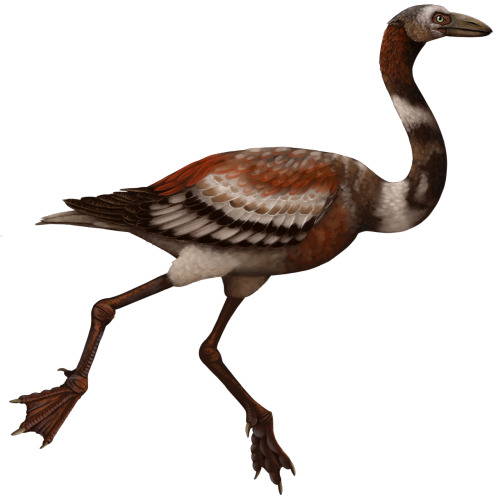
Despite their very different lifestyle, Palaelodus actually had similar habitat preferences to flamingos, inhabiting salty and brackish lakes and having nearly global distribution. The most well known species, Palaelodus ambiguus, Palaelodus gracilipes and Palaelodus crassipes were incredibly common in Oligocene to Miocene Europe, especially France and Germany, the former country having over a thousand bones of them. In France, all three species (which some have suggested is only a single species of varying size) coexisted with the large Megapaloelodus goliath and the true flamingo Harrisonavis.
Images by Alphynix, Ceratops Yuta's Dinosaur Travel Blog and Torres et al. 2015



Outside of Europe, fossils from Brazil are known and tentatively assigned to Palaelodus ambiguus as well. Indetermined palaelodids are known from the early Oligocene of Egypt (Jebel Qatrani Fm), one species named Palaelodus kurochkini stems from Mongolia. Three species are known from Oceania. Palaelodus pledgei and Palaelodus wilsoni are the smallest and largest species respectively, having been found in the Oligocene to Miocene deposits of the Lake Eyre Basin in Australia. A single species, Palaelodus aotearoa, is known from the paleo-Lake Manuherikia in New Zealand, known for its extensive fauna of waterbirds. Much like the European species, the two Australian taxa coexisted with true flamingos, Phoenicopterus novaehollandiae and Phoeniconotius eyrensis.
Palaelodus cf. ambiguus by Felipe Alves Elias, Lake Eyre flamingos by Frank Knight and Palaelodus aetearoa by Tom Simpson

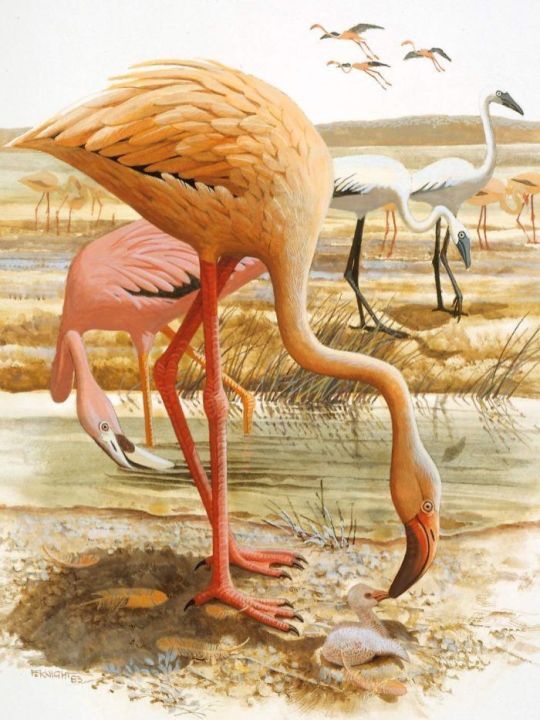

So all things considered, palaelodids and Palaelodus specifically did really well during the Oligocene and Miocene. What happened then is not known as they just disappear from the fossil record, unlike flamingos. Well, mostly disappear from the fossil record. There is one exception. A single isolated bone initially assigned to Palaelodus wilsoni was discovered at Cooper Creek in Australia, indicating an age of no more than 200.000 years. Since then its been suggested that it may not be P. wilsoni or even Palaelodus at all, but from the most recent publication I've seen on it the idea that its a palaelodid is still maintained. I am unsure on this one, as it is a massive gap in the fossil record, but there would be something tragic about it. Assuming that palaelodids survived in Australia, they would have been at home in a place that for a long time was a paradise for flamingos with salt lakes covering whats now the Tirari Desert. And then, during the Pleistocene when Australia got more arid and the lakes dried up, the former diverse flamingo fauna was gone for good, leaving Australia (and Antarctica) the only continents without flamingos, all because of some relatively recent climate change.

As always this is brought to you by me going down a wiki editing rabbit hole, the final result of which can be found here Palaelodus - Wikipedia. That article has all sources and information and then some more stuff that I didn't go in here (like the history and some anatomical lingo) Chances are that Megapaloelodus will be next, at which point I'll have written the pages for all fossil phoenicopterids and palaelodids.
#Palaelodus#Palaelodidae#Flamingos#Phoenicopteridae#fossils#flamingo#wikipedia#wikipedia editing#Palaelodus ambiguus#paleontology#palaeblr#long post
271 notes
·
View notes
Photo


Greater Flamingo
#greater flamingo#flamingo#Phoenicopterus roseus#Phoenicopteriformes#Phoenicopteridae#Phoenicopterus#bird#upl
155 notes
·
View notes
